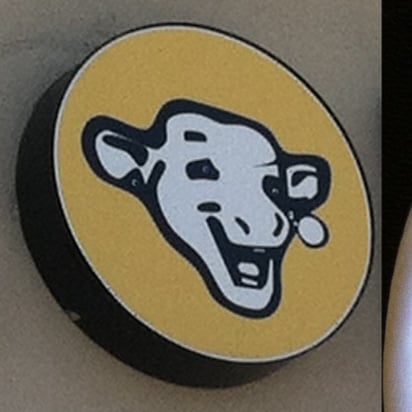

“How will we win if we can’t cheat?”


“How will we win if we can’t cheat?”


I once woke up from the couch and noticed this weird streak across the ceiling right above me. It was thousands of baby spiders.


I live in an area with tons of black widows. I’ll gladly kill them, cause they’d just as soon kill me back.


Yes. It’s really good at that actually. The browser can be cumbersome, but it’s not too bad for just basic browsing with a controller. I wouldn’t want to write an article on it, though. xD


If you’re going to dual boot, the latest version of Fedora makes that really easy to set up. Linux Mint is also a really good choice. For the love of god, avoid Ubuntu like the plague. It is not user friendly anymore. If you ever have to look up a guide on how to set up Flatpak, you’re in the wrong distro. Flatpaks should be front and center in the software center.
Btw, you don’t download installers from the internet like you do with Windows. You install software from the software app. On Gnome, it’s called Software, and on KDE, it’s called Discover. Fedora offers both Gnome and KDE. Since you’re new to Linux, I’d recommend KDE. It’s similar to the Windows layout.
Then Mint uses Cinnamon. It’s similar to a Windows layout. I don’t know what the software app is called. Cinnamon is really user friendly and familiar. You’d like it.
Then there’s Bazzite. Bazzite is great if you only want to game. Like, if you’re setting up a console-like PC for your living room. But, it does have some issues. The biggest one is that it’s immutable. That’s great (and actually beneficial) if you don’t need to change anything about the system, which you probably don’t anyway, but it gets annoying if you ever need to do anything more advanced. It also can only install containerized apps, so like Flatpak. (It can technically install packages, but they get wiped on the next update.) If you’re really 100% sure that you’re only ever going to game and do very basic things like browsing, basic photo editing, media, etc, then Bazzite would work for you. Remember to run the updater from Desktop Mode once in a while.
Since Linux is free and easy to installed, you can try out all and see which one you like. If you’re dual booting, that might be a bad idea, so instead, try them out using VirtualBox in Windows. In a VirtualBox, your games won’t run, btw, because they don’t have access to your graphics card.
If your games aren’t running well, you may need to install the Nvidia drivers from the software app. Just search for Nvidia driver, and you’ll find it. After an install and a reboot, your games should run fine.
Backup everything on your PC before you continue, in case anything goes wrong. As another user recommended, installing Linux to a separate drive is a lot easier and less problematic than trying to resize your Windows partition and use the same drive.
Final notes, some things to know about Linux:
/, and other drives get mounted to paths inside that. This is how normal computers have worked since the 60s. Windows has drive letters because it is based on DOS, which was weird. Also, it uses a slash to separate paths instead of a backslash. Again, backslash is a weird DOS thing.

I mean, Wine stands for “Wine Is Not an Emulator”.
Too many.
Good to know it’s not just US cops who are pieces of shit.


Definitely the left.


What are you talking about? Out of the 248 games in my Steam library, 190 of them are rated as working on Linux (Steam Deck Verified and Steam Deck Playable). 21 of them are untested, which means only 37 of them are rated as unplayable. Of those most are unplayable because they’re either VR games or they have restrictive anticheat. Some of them, like Medium, say they’re unplayable but work fine for me. I’m assuming that’s because the Steam Deck isn’t powerful enough to play Medium at more than 15 fps, but on my PC, it runs around 100 fps. Others, like GTA V, say they’re unplayable, even though I’ve fully played through them with no issue, even on the Steam Deck. I’m guessing that’s because GTA Online has anticheat, but I’ve played the single player and online and both have worked fine for me. (I just looked it up. They added BattleEye to GTA Online late last year, so yeah, GTA V is rated unplayable, even though the Story Mode is fully playable.)
I’ve even gotten games that refuse to work on Windows (like the original American Mcgee’s Alice and the original Journeyman Project) running great in Linux.
After running through a few of the untested games, some of them are untested, even though they have native Linux ports that run just fine. I’m assuming that’s because they haven’t been tested specifically on the Steam Deck.
Other than the ones with restrictive anticheat, everything I’ve tried from my Epic Games library works great too.
Of the games I play, almost none of them have worked worse on Linux than they do on Windows. Most work exactly the same, and a few work better. One (exactly one) has worked worse, for about a month, then a new version of Proton fixed the missing cutscenes.


A lot of stuff runs with windows emulation as if it’s native.
Proton is a compatibility layer, not an emulator. The binary is running on the bare metal CPU, just like on Windows. It’s only the system and API calls that are translated to their Linux equivalents. That’s why the performance is basically the same, unlike a hardware emulator.


First off, welcome to the light side.
Will my ability to play games be significantly affected compared to Windows?
It will be affected, but not significantly. Almost every Windows game works well on Linux. The notable exceptions are games that use anticheat software. They can detect that they are running in Linux and generally disallow it.
Many games perform better in Linux. A few perform worse. The vast majority perform exactly the same.
If you run games through Steam, everything should just work. You might need to enable the option “Enable Steam Play for all titles” in the settings. Honestly, if a game has a Linux version, I usually set the compatibility option in Steam to use Proton instead, because it just works, really well.
If you run other games, I recommend using Heroic Launcher for the game stores it supports, and Lutris for anything else. (Oh, and Prism Launcher if you play Minecraft.)
Something to note is that Windows games run through a compatibility layer called Proton, which is based on Wine. You can kind of use the terms Proton and Wine interchangeably, because Proton is just Wine + some enhancements for games. To the game’s perspective, it’s just running in Windows and making Windows system calls. Proton translates those calls to Linux system calls. It doesn’t emulate anything though, it just provides a Windows compatible API.
Can I mod games as freely and as easily as I do on Windows?
Maybe. Probably. If it’s running in Proton, then mods should work fine. You may need to add some launch parameters in Steam to load the mods first. You’ll also need to figure out the “Wine prefix” of the game to install the mod. The prefix is just the directory that Proton presents to the game as the C: drive, so it’s like having a specific drive for each game.
If a program has no Linux version, is it unusable, or are there workarounds?
This depends. Most programs will run through Wine. You can use Lutris to install them. I do this to run WinSCP on Linux. Some programs (notably, Adobe Creative Suite) don’t work with Wine. It’s usually better to find a Linux native alternative instead, but this isn’t always an option, so it’s nice to have some Wine once in a while. ;)
Can Linux run programs that rely on frameworks like .NET or other Windows-specific libraries?
Yes. Steam, Heroic, and Lutris will automatically install them for you.
How do OS updates work in Linux? Is there a “Linux Update” program like what Windows has?
OS upgrades are a lot easier in Linux. There’s one program that updates all your system software and apps at once. On Gnome, it’s Gnome Software, and on KDE, it’s Discover. This is also where you go to install apps. Don’t ever download anything from a website to install it (with the exception of Windows installers that you will be installing with Wine), just find it in these apps. It’s safer.
System software is installed through the package manager. Apps can be installed through Flatpak to make it easier.
How does digital security work on Linux? Is it more vulnerable due to being open source? Is there integrated antivirus software, or will I have to source that myself?
Security is generally better than Windows. Most Linux users don’t bother with antivirus for two reasons, viruses are really uncommon in Linux, and software isn’t installed from random websites, but package managers instead. A lot of things in Linux, like Flatpaks, are run in a sandbox too, so access controls are granular and permission based.
That being said, if you’re installing Windows software with Wine, then you’re at risk of installing a Windows virus on your Linux machine. Just like most Windows programs work well in Linux through Wine, most Windows viruses work well in Linux through Wine.
Are GPU drivers reliable on Linux?
Very. If you’re using an Nvidia GPU, install the Nvidia driver through your package manager. If you’re using anything else, they’re already installed.
Can Linux (in the case of a misconfiguration or serious failure) potentially damage hardware?
Probably not. Technically, yes, but it’s extremely unlikely and isn’t something you should worry about. Windows can too, btw.
And also, what distro might be best for me?
Fedora, Mint, or Pop OS should be your starting points. Steer clear of Ubuntu. Ubuntu used to be very user friendly, but lately it’s been atrocious. Fedora has always been awesome, and it’s very user friendly. Same with Mint.
More importantly, what desktop environment should you use. Fedora Workstation offers both Gnome and KDE, the two big ones. Either one will work great for you, but KDE is more similar to a Windows layout by default. Mint uses Cinnamon, which is very user friendly and similar to a Windows layout. Pop OS uses Cosmic, which is new, and in development. It’s promising though.
Some final thoughts I want to share with you:
Linux uses a Unix like file structure, so you don’t have drive letters. Instead, you have a root file system, and other file systems are mounted within it. Your root file system is just a slash /. It’s like your C: drive. Directories are separated by forward slashes, not backslashes. Not something you should worry about, just something to know.
Linux is a diverse field of operating systems, and some work very differently than others. They range from super easy and approachable, to wildly difficult to learn. Some are specialized for gaming, like Bazzite, while others are general purpose, like the ones I mentioned above. Technically, “Linux” is just the kernel, like “NT” on Windows, but most people mean a complete operating system when they say Linux.
You should learn about the difference between Wayland and X11. Just some basic overview of them. You don’t really need to know, but it might be worth it. Basically, Wayland is new and more secure, X11 is old and less secure. Wayland can run X11 apps just fine, so it really shouldn’t matter to you. Wayland is also the default nowadays.
You probably won’t need to use the terminal, but if you do, don’t be scared of it. It’s just a way to launch programs that generally don’t have a UI.
Lastly, Linux is free and easy to install, so don’t be afraid to try out a bunch of different distros and desktop environments and see which works best for you. Once you find one you like, you can always switch to something else in the future if it stops working for what you need. Also, backup early and often. I use Pika Backup. It’ll help if you forget to grab something before you reformat your drive.

Tell him his job is perfect to be replaced by AI.
“Too late. Potato salad with mayo or without?”
(Source: Google Translate)


I mean it’s like maybe a dollar or two for the labor costs, so that’s understandable. I’d still prefer just a blank SSD anyway.


This is awesome and I love it. Maybe they could even take a few more dollars off by not having any OS installed (bypassing the labor costs of imaging an SSD). I’ll be installing my own copy anyway, so I’m fine with a blank SSD.


He’s literally just doing what he said he would do. Did they not believe him, or were they too busy watching fake news to bother listening to what he said? I have no sympathy for the ones who voted for him, but unfortunately this affects the majority who didn’t.


So one of the biggest problems Flatpaks solve is that you can have different versions of dependencies installed at the same time (in this particular case, it’s a problem, because the Nvidia drivers are huge). Imagine you have two packages, P1 and P2. Both depend on library L1, but P1 depends on the newest version, L1 2.0, while P2 depends on the last version, L1 1.0. If the package P2 is open source, you can just rename L1 1.0 to L1-1 and patch it, but if it’s not open source, you can’t patch it, and P1 and P2 can’t be installed at the same time.
It also saves developer time, because the OS devs don’t have to maintain a package for every single app that comes out for Linux. Instead, the app developers make one package with all the dependencies they need and the right version of each and push it up to Flathub, where it can be installed on every OS.


But Trump said he could end the war in 24 hours. Is Trump a… a… liar? shockedpikachu.jpg
“Fuck your rights.” - the party who claims to love the constitution